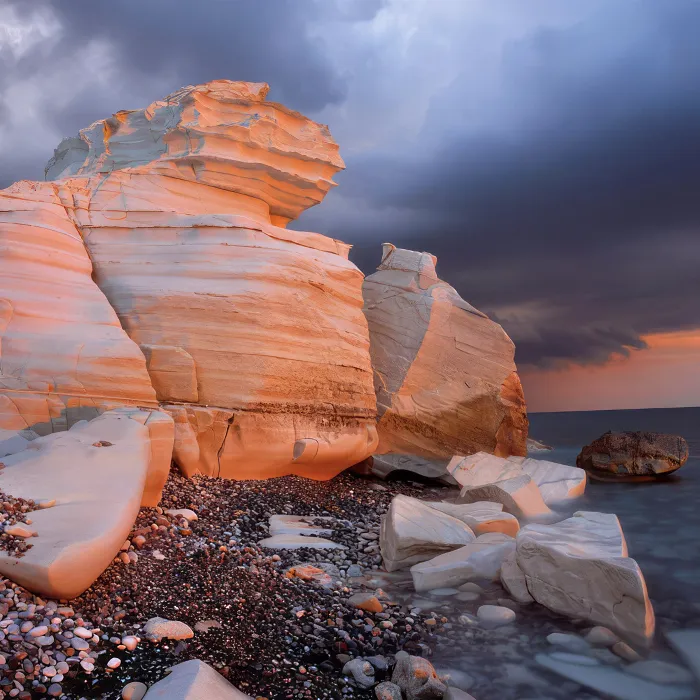Experimental photography out of frustration and boredom. The camera and lens (and of course the photographer) were directly above the ground. Despite the short shutter speed of 1/500 second, the ice crystals are already shown as a short line. Canon EOS 5D Mark II, EF f2.8, 14 mm L II at aperture 22!!! and ISO 640. Grubigstein, Lechtal Alps, Austria.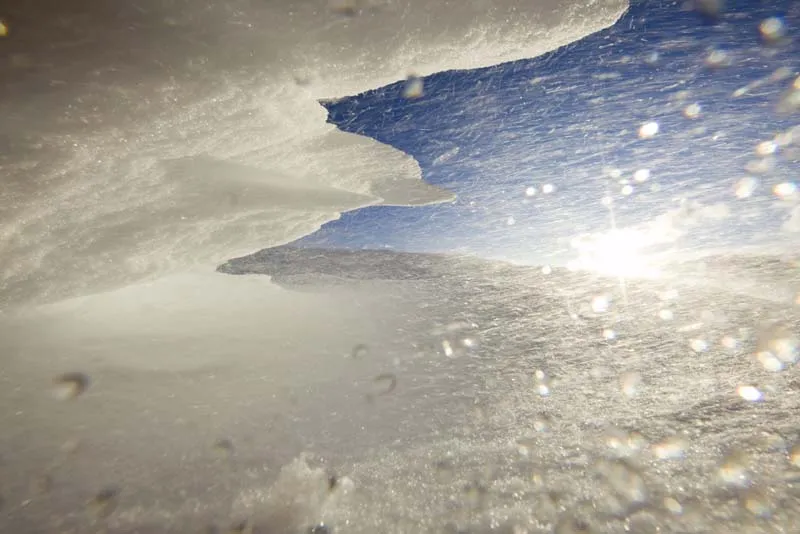
Grubigstein, Lechtal Alps, December 2008. Again and again the Föhn storm on the summit ridge pushed me roughly to the ground. Ice crystals maltreated my skin like needles. Ice and snow penetrated everywhere, into every opening in my clothing, but also into every tiny crack in my camera and lens. On the Zugspitze opposite, gales of up to 180 kilometers per hour were measured that afternoon, with an air temperature of minus 16 degrees. Wrapped up thickly in an anorak and overtrousers, wearing a balaclava and ski goggles, I waited for things to happen. I lay in the snow and simply "played dead", at least when gusts of wind swept over me. They usually announced themselves with an acoustic mixture of thunder and a rumbling express train. As I said, I wasn't lying in the snow on Mount Everest, not even on Mont Blanc, but on the 2232-metre-high Grubigstein. My aim was to photograph the mighty west face of the Zugspitze in the evening light. The light was good, the subject was beautiful, but it was impossible to take a photo. I didn't manage to set up the tripod or take the time to compose a picture. The only things I managed were a few self-portraits and details of snow drifts in the storm. But after just a few shots, the camera and lens were completely iced up and therefore unusable ...
What went wrong? Could I have done something better?
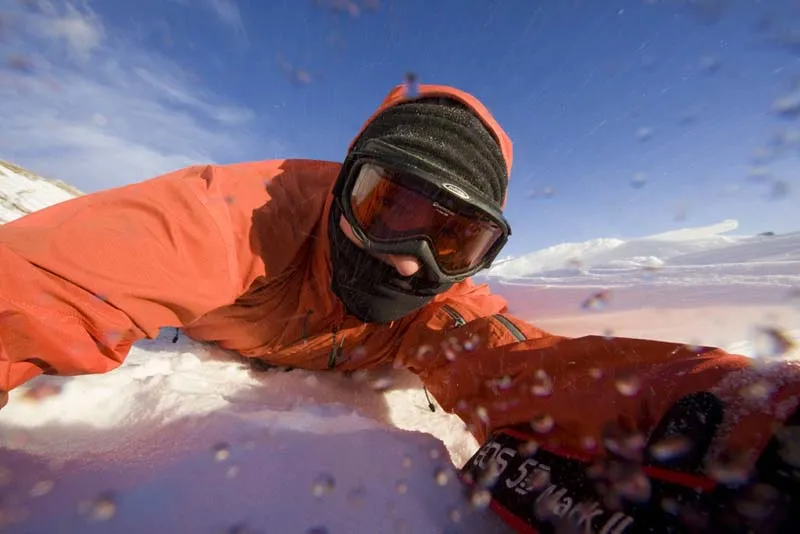
Self-portrait in a storm. Due to the relatively "slow" shutter speed of 1/80 second, the very fast ice crystals are already shown as a longer line. Canon EOS 5D Mark II, EF f2.8, 14 mm L II at aperture 22!!! and ISO 640. Grubigstein, Lechtal Alps, Austria.
First of all: This tutorial is not about technology or comprehensible technical tips. I can and would simply like to pass on my experience with this problem. Perhaps one or two photographic "weather gaffes" can be avoided.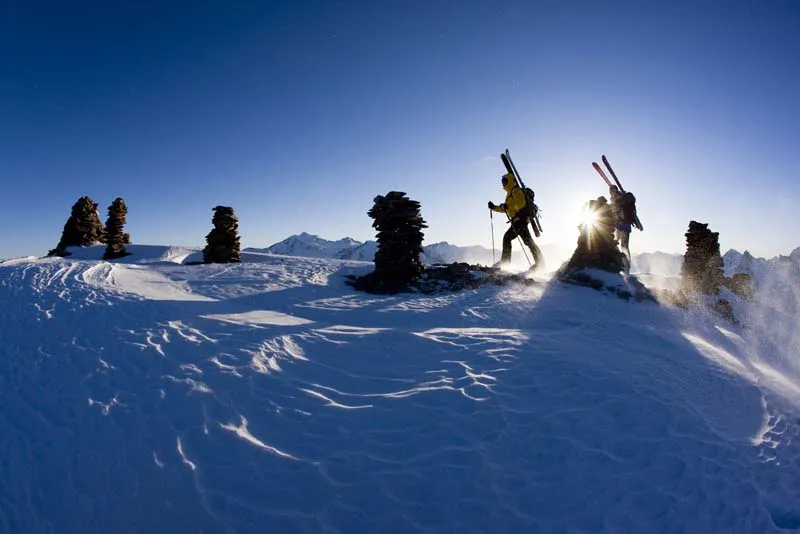
Visually a "good weather picture". However, the conditions were uncomfortable: very cold and a high altitude storm. Canon EOS 5D, EF f4.0 17-40 mm L at Blender 8 and ISO 320, shutter speed 1/1250 second. Wassertalkogel, Ötztal Alps, Austria.
Cold and storm - snow and ice
There are many factors that can make photography difficult in the high mountains and in winter nature in general. The thick, bulky clothing makes us cumbersome, the cold paralyzes our movements, plus often clunky gloves that don't exactly make operating small "mouse cinemas" on cameras any easier. In my opinion, gloves with a fold-down cuff (Mammut, Salewa) are ideal. With them, I have my fingertips free to work without restriction. If the fingers are cold, the cuff can be folded back over and after a short arm circle everything is usually "warm" again. However, the small buttons still make operation difficult. At least with modern SLR cameras in the medium and upper price range, the dials and buttons are now finally sealed to some extent. The sensor also has no problem with the cold. Quite the opposite: low temperature means less noise!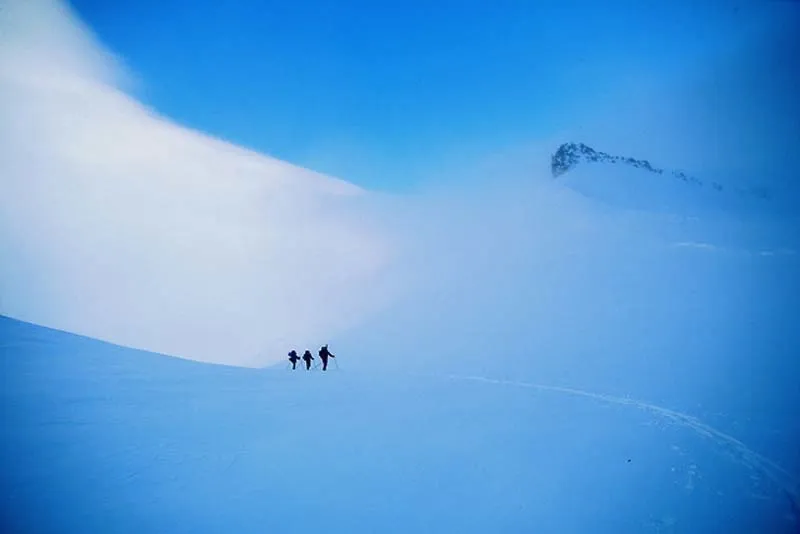
At the end of a two-week winter crossing of Spitsbergen, the last pass before Longyearbyen was briefly torn open by a storm. Temperature minus 28 degrees, wind speed approx. 80 km/h. But despite the extreme conditions, I surprisingly had no problems with either the camera or the films. Canon F1N, FD f3.5 20-35 mm L, Fujichrom 100, Spitsbergen.
The power problem: The current lithium-ion batteries used in cameras are basically cold-resistant - but only when they are new. After just one year with an average number of charging cycles, their performance decreases. After two years of intensive photography, they are just as "empty" as most cell phone batteries after this time.
I always carry a spare battery with me on tour, which I keep as warm as possible on my body. On longer trips (ski crossings, treks, etc.) without the possibility of recharging, I carry up to four spare batteries, all freshly charged, of course.
The fact is: high-quality cameras also work at temperatures well below minus 20 degrees and the power supply can be guaranteed, at least for a few days. The really long trips are difficult. For a few years now, high-quality mobile solar panels have finally been available from the company Solarfocus (Krimmer Outdoor). I have now tested them on various trips, including in the Andes in very cold conditions. My conclusion: they work very well in warm regions.
In the cold, however, there is almost no ion flow, i.e. it is difficult to charge lithium-ion batteries despite the sun. However, there are a few tricks to mitigate the problem: I pack the charger, the buffer battery, the battery to be charged and a drinking bottle with hot water in my sleeping bag and lay it on the insulating mat in the sun, with the open solar panel next to it. Even at 20 degrees below zero, the charging unit remains warm enough to allow charging.
And lo and behold ...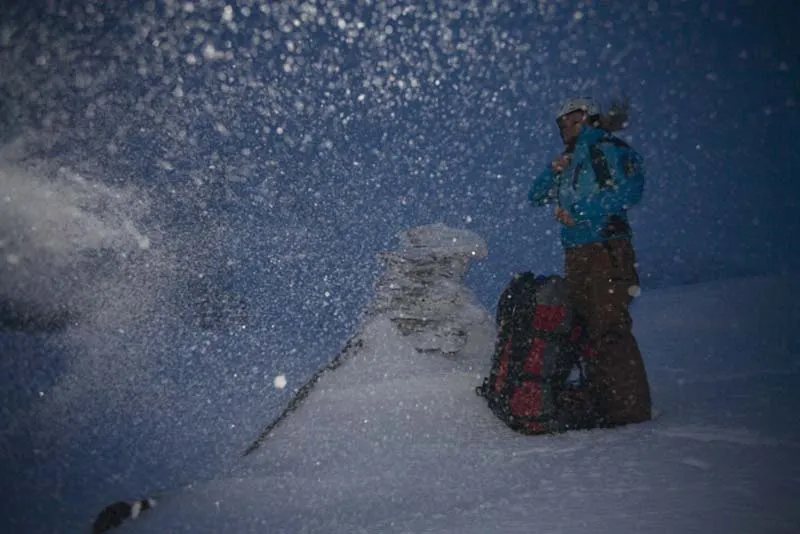
"Trip into the Darkness" is what we called a week-long photo production in the Lyngen Alps of northern Norway in mid-December. The extreme cold, the storm and the constant darkness (with a brief period of twilight around midday) were a major photographic challenge. Many underexposed images unfortunately resulted in a lot of noise. Canon EOS 5D, EF f4.0 17-40 mm L at aperture 4, 1/15 second, Blender and ISO 250. Rundtinden, Lyngen, Norway.
Good preparation is everything. Even under really adverse conditions, there are a few tricks to take as many good pictures as possible for as long as possible. The default settings on the camera are important.
In extreme conditions such as those described above on the Grubigstein, I determine important parameters in advance (e.g. in the lee of a rock):
- 1. a high ISO sensitivity to avoid blurring the shots as much as possible (e.g. ISO 400 or 800).
- 2. the lens, preferably a zoom lens, in order to have more possibilities.
- 3. determine the aperture, usually an average value around f/8 in normal lighting conditions.
- 4. finally, I make sure that there is enough space on the memory card. Then everything has to go very quickly: Lens cap down - frame the picture - release the shutter several times - put the cap back on.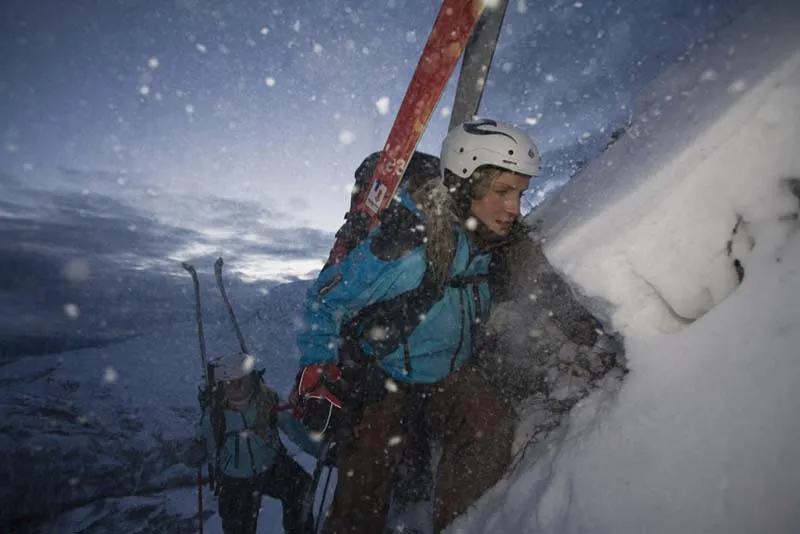
At lunchtime, despite the cold and storm, we enjoyed the brightest phase of the day at Goalborri. Nevertheless, without the flash, there would hardly have been anything to see of the person. Under such conditions, I sometimes have to "force" myself to be disciplined in my photography. Canon EOS 5D, EF f4.0 17-40 mm L at f/4, 1/60 second, Blender and ISO 250. Goalborri, Lyngen, Norway.
A valuable protection for the lens during snowstorms (but also sandstorms or rain) is the lens hood. The front lens stays dry and clean much longer with it, especially with the long lens hoods of telephoto lenses, than without any lens hood.
If possible, I don't shoot against the wind, but try to use motifs to the side of the wind or with a tailwind. Very important: When there is a storm, i.e. snow and ice crystals in the air, changing lenses outdoors should be avoided at all costs in order to protect the sensor. Even the best sensor cleaning is useless when ice crystals are "melting" on the sensor.
If a lens change is really necessary, I turn into the slipstream and change the lens in front of my body inside the anorak. (Caution: tight with a growing belly!!!) In any case, the camera should be held with the bayonet facing downwards so that the dirt/snow falls out rather than in. I only clean the damp, sometimes icy camera equipment in a dry and protected room. This does not have to be warm! In heated rooms, the camera and lenses would fog up anyway and not be able to dry at all over a longer period of time. I usually leave the camera bag unopened in the room and wait until the temperature has adjusted.
Alternatively, or if it has to be done quickly, you can also put the camera and lenses (still in the cold) in a plastic bag and take it into the warmth with it sealed and with as little air as possible in the bag. The condensation will now form on the bag and not on the camera.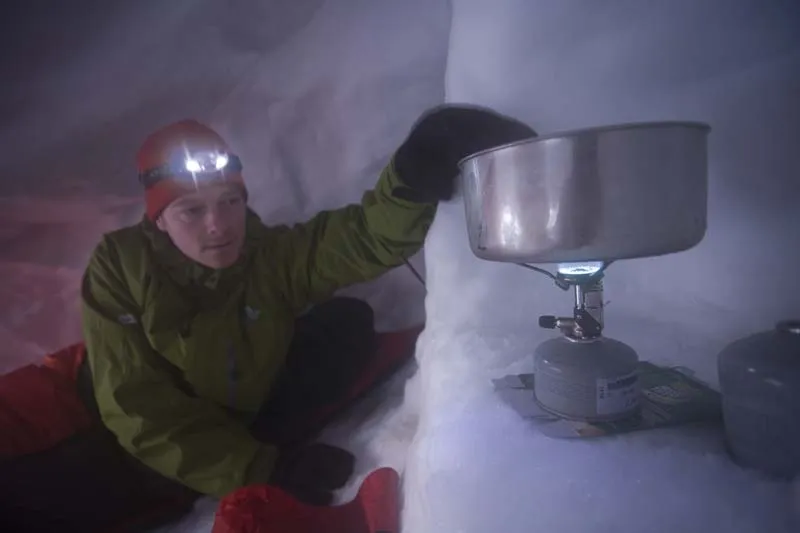
In a snow cave it is usually much warmer than outside (in this case minus 1 degree instead of minus 15 degrees), but also much more humid. The front lens was slightly fogged up despite temperature adjustment. Canon EOS 5D, EF f4.0 17-40 mm L at Blender 4 and ISO 400, shutter speed 0.3 seconds, tripod. Geißkopf, Zillertal Alps, Austria.
What else is important for taking good pictures in a snowstorm? Nerves of steel, calm and concentration. The most important thing, however, is experience: not only to take pictures at all, but also to pack up the camera again in time with common sense and discipline. My thumbs and toes, which have frozen several times, have unfortunately made this factor painfully clear to me time and time again. If it weren't for the never-ending hunt for the perfect picture ...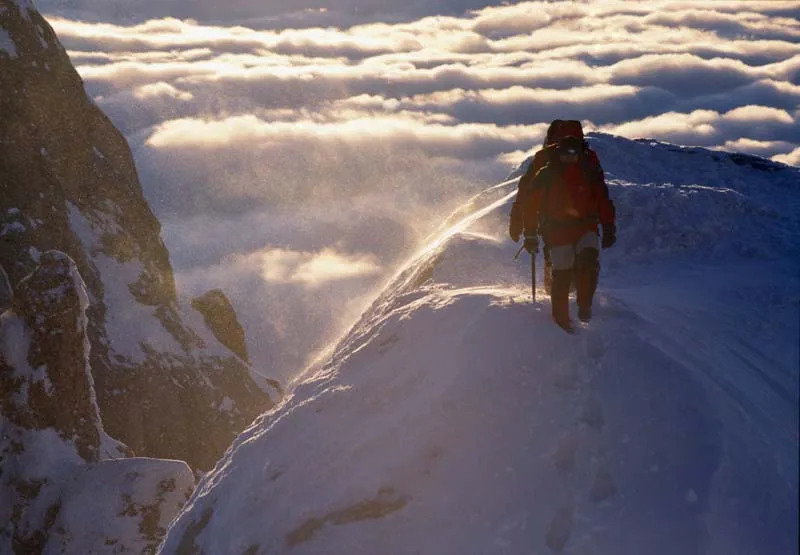
Minus 25 degrees and a high altitude storm on the summit ridge of the Marmolada. A perfect sea of fog above the valleys. The result was four exposed films and two frozen thumbs due to film and lens changes!!! Canon EOS 1V, EF 3.5-4.5 70-210 mm, Fuji Velvia. Marmolada, Dolomites, Italy.
For this shot of a sand dune in a storm I risked damage to the camera and lens (which was stupid). The fine, swirling sand unfortunately gets everywhere.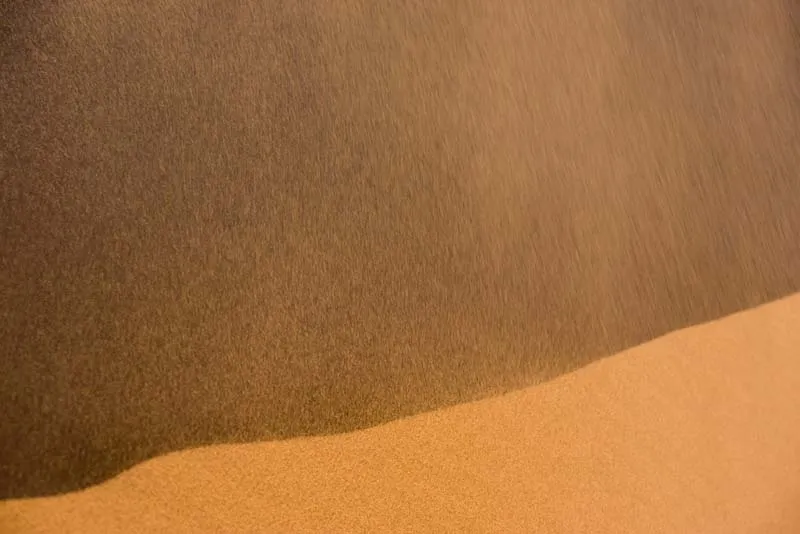
It is almost impossible to "protect" here. Canon EOS 1Ds MK III, EF f4 70-200 mm L IS, Blender 8 at 1/250 second and ISO 320, tripod, Sossuvlei, Namib Dessert, Namibia.
Heat, sand and dust
First of all: I don't like heat, sand and dust. But sometimes you just can't avoid traveling to desert regions. Hats off to all photographers who feel comfortable in such areas and also take good pictures.
However, the problems and hardships that we "fight" against there certainly have parallels to the cold regions of the world. Many of the "cold tips" are therefore also helpful in the deserts: holding the camera with the bayonet facing downwards when changing the lens, which is of course best done in closed rooms, vehicles, bags!!! or at least inside a jacket in the lee.
The sun visor is also important, not only to protect the front lens from blowing sand, but above all to minimize stray light and reflections (whether in the snow or in the desert). A really tight camera bag is even more important in the desert than in the mountains.
The fine sand of a desert storm really does penetrate everywhere. Many colleagues transport their equipment in Zarges boxes (robust, leak-proof aluminum boxes) on long desert tours in order to protect it perfectly. But what do I do if I have to carry all my equipment 100 meters up a dune?
I prefer modern photo backpacks with waterproof zippers and integrated rain covers in all regions and under all climatic conditions on this earth and actually manage quite well with them.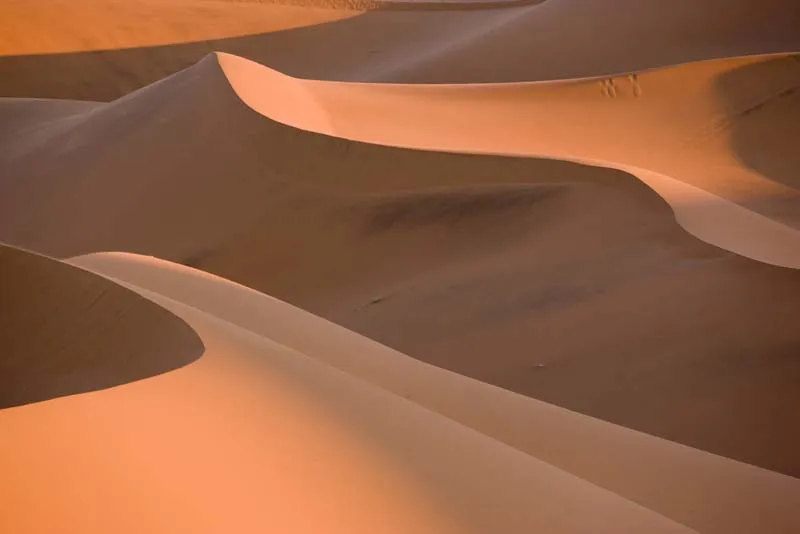
But the desert can also be beautiful. Provided there is no wind and it is pleasantly warm, as in this shot. Canon EOS 1Ds MK III, EF f4 70-200 mm L IS, Blender 6.3 at 1/80 second and ISO 320, tripod, Sossuvlei, Namib Dessert, Namibia.
I would like to recommend a small but very important accessory at this point: the blower brush. Not only to remove sand and dust from the camera and lens (always hold the surface to be cleaned downwards), but also to clean the sensor (in an emergency!!).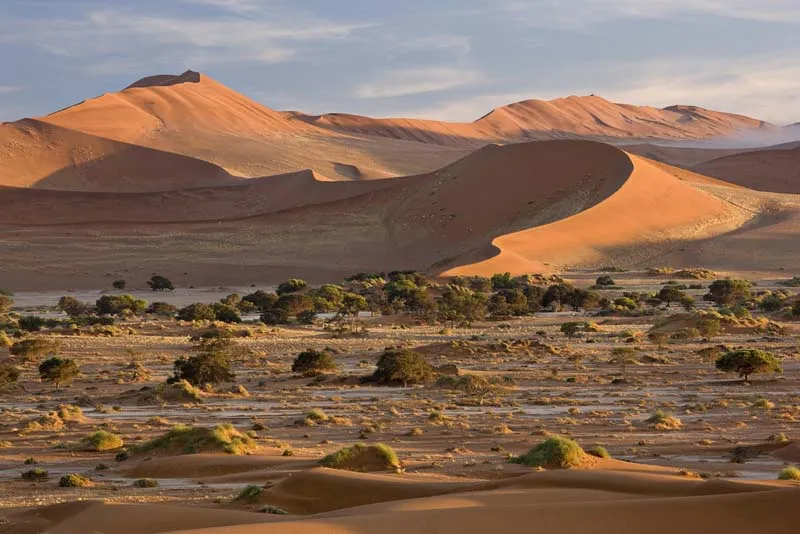
The desert is alive. But not only in the form of bushes, grasses and trees. Two hours later, there would have been dozens of vehicles and tourists down in the valley. This deserted shot was only possible for a short time after sunrise. Canon EOS 1Ds MK III, EF f4 70-200 mm L IS, Blender 13 at 0.6 seconds and ISO 50, tripod, Sossuvlei, Namib Dessert, Namibia.
Moisture and rain
A gentle spring rain can be photographically enriching. A tropical monsoon rain, combined with leeches, mosquitoes, 100% humidity and a temperature of 38 degrees Celsius can drive a photographer crazy. The wetness disaster begins with a damp camera bag, progresses to musty, musty clothing and ends with mold between the lenses. In an Alaskan snowstorm, I manage to stay calm and concentrate on taking photos, but a real tropical jungle is, at least for me, a borderline mental challenge. I'm not talking about the nice cloud forest on La Gomera, but really the rainforests of Africa or South America.
Virgin forest for beginners on La Gomera. However, it is just right as an introduction and for "playing" with photography. Mist, drizzle and high humidity make for lush greenery. Nevertheless, an anorak and umbrella can be very useful. Canon EOS 1Ds MK III, Zeiss f2.8 21 mm, Blender 11 at 1/10 second and ISO 250, La Gomera, Spain.
We need to be optimally prepared for these conditions. What equipment do we need to take exciting pictures under these conditions? A good, waterproof camera bag/backpack with an additional rain cover should be a matter of course. In my opinion, if you are traveling to really wet and rainy regions, you also need a high-quality sealed camera and sealed lenses.
For boat trips, river crossings and "floods" of any kind, I always have a waterproof bag, e.g. from Ortlieb, in my luggage. In an emergency, the entire photo backpack disappears into it within seconds. If you want to be on the safe side, you can take a small waterproof viewfinder camera with you, e.g. as a backup for the SLR camera.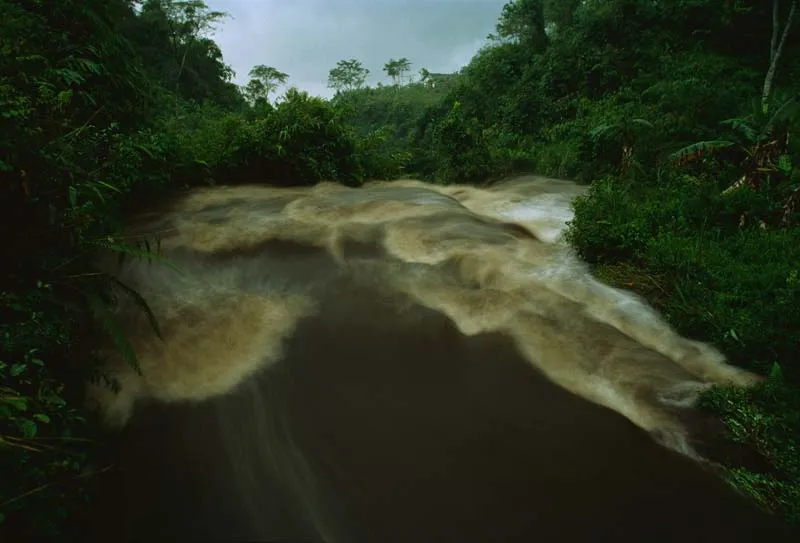
I waited in the car for over an hour for the tropical monsoon rain to subside. When it finally did, I ran barefoot and in shorts into the muddy mire, set up the tripod and took a series of shots. I had the umbrella tucked between my neck and head. The slow shutter speed in combination with the polarizing filter made the brown broth "flow" expressively. Canon F1N, FD f3.5 20-35 mm L, Fujichrom 100, polarizing filter, tripod. Baturaden, Java, Indonesia.
During the photography itself, I try to work under an umbrella whenever possible. Attached to the chest and waist straps of the rucksack, you can take really acceptable photos under its protection. I first dry fogged up or really wet cameras and lenses carefully with a lint-free antistatic cloth. Then I wrap them in a cloth or a dry sock together with a few packets of moisture-absorbing silica gel.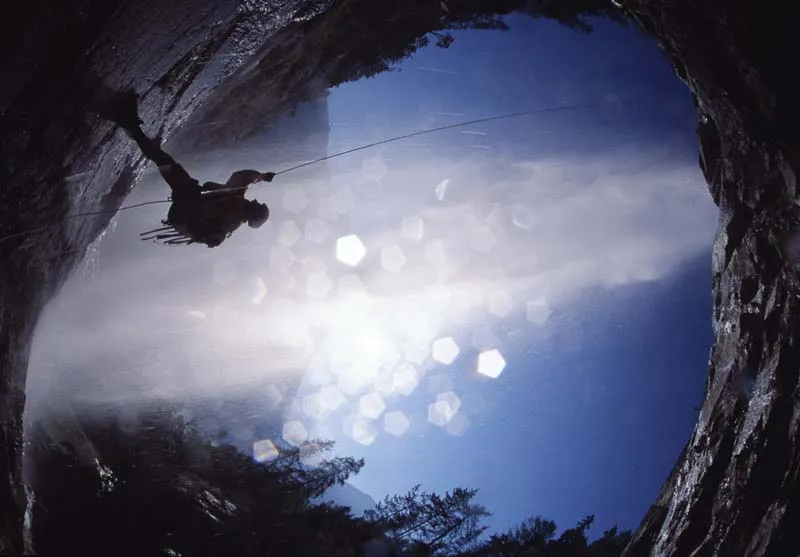
Canon EOS 1V, EF f2.8 17-35 mm L, Fuji Velvia. Lehner waterfall, Ötztal Alps, Austria.
This shot almost cost me my life. With a 100 meter long static rope (11 mm) we rappelled down behind the Lehner waterfall. Completely soaked, I took a few pictures of Andi and Roland. I always had to dry the front lens after every three or four pictures.
There was spray and water dust everywhere. When I climbed up (ascent with ascenders) on the fixed rope, it rubbed through the sharp rock except for a few strands.
I was simply lucky.
As difficult as the rigors of nature may be for photographers, the pictures can be impressive and meaningful. They show the elemental force of the elements, the beauty of the wilderness and the adventures of us humans. Have fun and good pictures!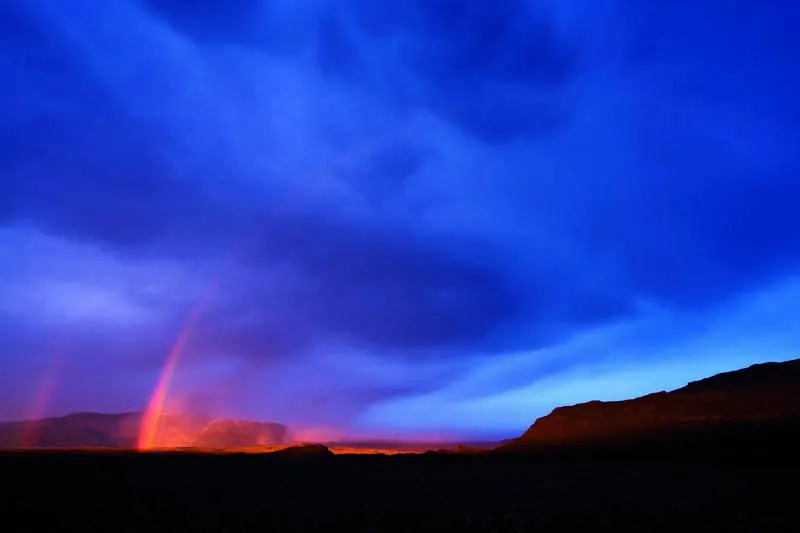
This rainbow formed in the gloomy evening sky for just a few minutes. The storm and the resumption of rain made photography difficult. My body served as wind protection behind the tripod. Canon EOS 5D, EF f4.0 17-40 mm L at Blender 16, 1.3 seconds, ISO 50, tripod.Hafrafjell, Iceland.
